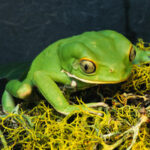Winnie the Pooh is charming, innocent, uncomplicated, sweet, and often times quite funny. It isn’t, however, so innocuous that it neglects adults, which is good because I’m sure many of them will dutifully take their children to see it. In three distinct ways, it represents the rediscovery of one’s roots. The first is in respect to Disney, who have gone the extra mile and made a traditional cel-animated film; I was convinced I had witnessed a rebirth with the 2009 release of The Princess and the Frog, but alas, 2010’s Tangled reverted to 3D computer animation, which made the film far more commonplace that it should have been. The second is in respect to the original stories by A.A. Milne, of which three have been adapted for this film. The third is in respect to older audiences that appreciate the painstaking art of hand-drawn animation and remember with longing the wonderful simplicity of Milne’s stories.
Much like 1977’s The Many Adventures of Winnie the Pooh, this new film opens with live-action footage of Christopher Robin’s room, filled to the brim with all manner of knickknacks an English boy might have collected nearly ninety years ago. These include several stuffed animals, one of which is a roly-poly teddy bear wearing a red shirt. The narrator (the voice of John Cleese) then directs our attention to a book sitting by itself, which magically opens and reveals a very childlike sketch of the Hundred Acre Wood. The Sherman Brothers’ original “Winnie the Pooh” song, now sung by Zooey Deschanel, begins to play as cartoon figures mill about the page, in effect introducing — or rather, reintroducing — themselves to the audience. The pages turn, and the first chapter begins.
We then watch in sheer delight as Winnie the Pooh, Pooh for short (voiced by Jim Cummings), goes on a search for honey. His stash has completely run out, and his tumbly is rumbly. On the way, he will discover that his friend, gloomy old Eeyore (voiced by Bud Lucky), has lost his tail. Christopher Robin (voiced by Jack Boulter) gets involved and decrees that whoever finds a suitable replacement tail for Eeyore will receive a fresh supply of honey as a reward. Later on, Pooh discovers a note left by Christopher Robin, which he can’t read because … well, I think he says it best: “I am a bear of very little brain, and long words bother me.” He shows the note to Owl (voiced by Craig Ferguson), who misreads it, but does so with the utmost confidence. According to him, Christopher Robin has been kidnapped by a furry, horned beast which apparently calls itself the Backson. Pooh and his friends make haste to set a trap for the creature and reclaim the stolen boy.
We will, of course, reunite with all of our favorite characters, including the timid but loveable Piglet (voiced by Travis Oates), the responsible but easily irked Rabbit (voiced by Tom Kenny), the motherly Kanga (voiced by Kristen Anderson-Lopez), her feisty little son Roo (voiced by Wyatt Dean Hall), and the ever bouncy, ever ready-to-pounce Tigger (also voiced by Cummings). The only exception is Gopher, probably because, as he repeatedly said in 1977’s Pooh, he’s not in the book. A new character will be introduced, although I will not reveal its name or the voice talent. I will say that you’ll have to sit through the end credits for that introduction. That will actually be fine because the filmmakers took steps to make them just as enjoyable as the rest of the movie.
The look of the film is nothing short of beautiful, each frame evoking the handmade feel of E.H. Shepard’s original illustrations. That the story unfolds within the context of book pages only adds to the charm. There will be many instances in which the characters will engage in literal wordplay; they will bump into or climb over or fly around or manually manipulate black letters as they appear on each page. If I’m not mistaken, I think the font was Times New Roman. The best visuals are reserved for two fantasy sequences, one involving chalkboard illustrations as Owl sings a song about the Backson, the other showing Pooh happily lost in a world made entirely of honey. The latter starts out, not surprisingly, as a series of food hallucinations.
The greatest thing about this movie — and indeed, with any incarnation of the story — is the harmlessness with which it’s told. On the one hand, we have a boy, who, even in the realm of animation, will almost certainly grow up someday. On the other hand, we have his make-believe friends, who have forever been imprinted with his youthful sense of imagination and innocence. Little touches, like misspelled words and backwards letters written in childish scrawls, prove this to be true. In this world, “honey” will forever be “hunny,” and if that bothers you, perhaps you should consider a long and fulfilling career as a grammar teacher. Winnie the Pooh is terrific family entertainment — a film that will give young ones colorful characters to relate to and not-so-young ones permission to reminisce about an easier, simpler time.

